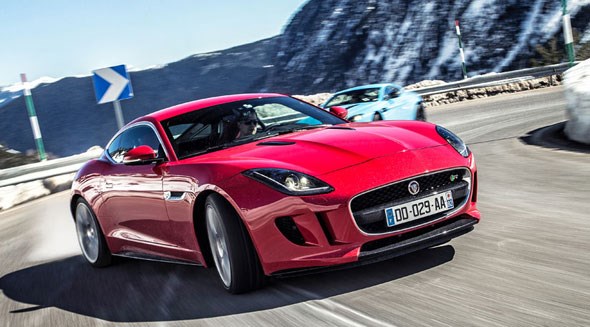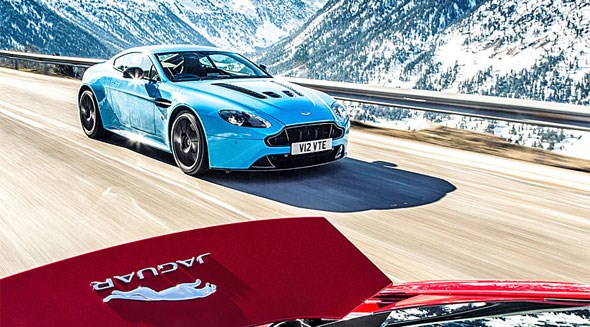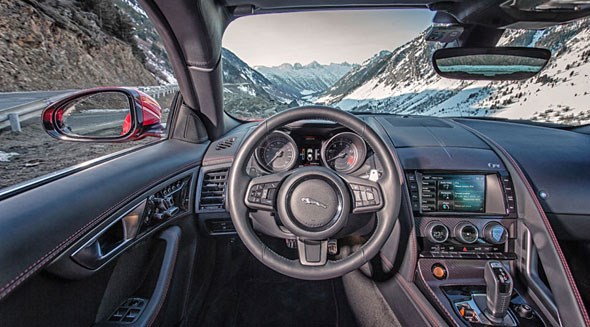Photography by Richard Pardon
From the big Healeys of the 1960s to the TVRs of the 1990s, we Brits have always known how to put together a properly exciting front-engined, rear-drive two-seater. Well, maybe not how to put it together, but you know what I’m getting at. Italy has supercars; Britain has the Jaguar F-type R Coupe and Aston V12 Vantage S, and we’ve climbed high into the Pyrenees to find out which is best.
CAR’s editor at large, Ben Barry has already had a chance to try the F-type Coupe on track, but this is our first opportunity to pit it against some real roads – and to try to make a set of tyres last more than half a mile. Like its roadster sister, the F-type Coupe comes in three flavours: V6, V6 S and a flame-spitting V8. Countering criticism that Jag overpriced the open-top cars, the two V6 Coupes are £7500 cheaper than the mechanically identical open varieties. But if you want a V8 Coupe, you’ll pay £4000 more than the £80,000 needed to get into a V8 S roadster. The pay-off is a 55bhp jump to 543bhp, and a new name: F-type R.
On a purely financial basis, the R’s most natural Aston-built rival would seem to be the entry level V8 Vantage, yours for £86,000, or with the comically overpriced automated manual, for an extra five. But 125bhp down on the Jag, the battle would have been over before it started, and based on previous experience, even the slightly meatier V8 S would have struggled.
Watch CAR’s Jaguar F-type R Coupe video review here.
Jaguar F-type R Coupe vs Aston Martin V12 Vantage S twin test
There was only one course of action: bring out the big guns. Aston Martin’s mighty V12 engine is as big a gun as the little Vantage holster can take. Yes, at £138,000, it’s a bonkers £53k more than the F-type (not to mention £38k more than a 911 GT3). But in power and performance, it’s bang on the money. There’s no doubt that Jag will turn out an even more hardcore F-type R-S in time but, for now, this pair are at the top of their respective trees. Both are among the world’s most hardcore GTs, but only one demands you drive it until you’re literally hanging in the seatbelt or you’ve drained the tank dry.
From the moment I clapped eyes on our Salsa Red F-type, hunkered down outside the front of Barcelona’s Mandarin Oriental Hotel, I knew it was going to be the Jag. The Convertible had to come first to keep the crucial American market happy, but this tin-top, for us, is the definitive F, just as the fastback E-type so comprehensively outcools its open-air sibling. Just cast an eye over the F-type configurator on the Jag website, see the horrible OAP-spec alloy wheel designs fitted to the lower-spec V6 cars and you know that Jag still knows how to snatch defeat from the jaws of victory.
But in R-spec the thing looks sublime, quad exhausts poking from beneath those E-type-inspired rear lights, and subtle sill extensions like the webbing on a skydiver’s wing suit telling the world that this is no V6 boulevardier.
Inside the Jaguar F-type R Coupe’s cabin
The cabin is no disappointment, either. I love the modern typography on the twin-gauge instrument cluster, the precise click of the three rotary dials that combine air-con and seat-heating functions, and that Jag has finally seen fit to deliver proper metal gearshift paddles. Compared with our long-term V6 S convertible (paint the colour of Ron Burgundy’s suit, horribly mismatched to black wheels; leather whose first home was an elephant’s backside), it feels genuinely expensive in here.
Only the usual Jag hard-to-hold steering wheel and clunky old infotainment system lets the side down. The new Intel-based replacement due this autumn can’t come soon enough. Bags stowed in the Coupe’s vastly more useful luggage bay, we punch the starter button to wake up the 5.0-litre supercharged V8 and begin to pick our way through Barcelona’s morning rush-hour traffic.
Fast forward three hours, and by the time we stop for coffee in Sort, 692m above sea level in the Pyrenees, while we await the arrival of associate editor Damion Smy in the Aston, I’m feeling lottery-win good about the F-type.

Jag says the Coupe’s shell is 80% stiffer than the already resilient roadster’s, and you’re left in no doubt of that by the feel and accuracy of the steering. And I’m as genuinely surprised by how much tighter it all feels through the bends, as I am by the incredibly low noise levels when cruising on the dual carriageways to get us here. The F-type might be the most extreme Jag for years, but it still melts motorway miles away as effortlessly as an XJ limo.
From our pavement cafe’s wicker seats we can see the admiring glances the parked F-type is drinking in as it basks in the low-slung winter sun 20m down the road. And we can see those same heads swivel like owls hooked up to the National Grid when Damo rolls into town in the Vantage.
I suspect that has as much to do with its striking blue paint job, which looks the colour of one of those Invacar disability chariots viewed through a pair of polarising sunglasses, but whatever the reason, the Aston is about as jaw-slackening as front-engined sports cars come.
>> Click ‘Next’ to continue reading our Jaguar F-type R Coupe vs Aston Martin V12 Vantage S review
From a front-three-quarter angle, it looks too short, like a three-quarter scale DB9 commissioned by a tycoon for his 10-year-old kids. And the detailing, the clear rear light lenses, those Sapphire Cosworth bonnet vents, is a million miles away from the regal gentility of a basic V8 Vantage. But while the latest Vanquish’s One-77-inspired refresh has highlighted the 11 Christmases since we first clapped eyes on the DB9/Vantage silhouette, this remains undoubtedly a beautiful shape.
If only the cabin was quite so slippery when it came to evading Old Father Time. You’d not call it ugly, by any means, but it feels so old it’s almost a surprise not to find a National Trust volunteer lurking in the passenger seat ready to furnish some fascinating facts about the lineage of the HVAC controls. The sat-nav system, recently improved by a switch to Garmin techy bits, is still nowhere near as usable as rivals’, and the ancient monochrome radio display looks like a pager doctors wore in the early ’90s. It’s a stark reminder that despite the constant tinkering, the Vantage is an old car. Can it really expect to cut it against a brand new rival? Time to find out.
I stick with the Jag for the next leg, keen to find out how it copes with the elevation changes, switchbacks, and sprints between them I’ve spotted on the map. The transmission’s insistence on you pulling the trigger fitted to the mandatory auto ’box’s shift lever when you want to move it has already annoyed us (remember when you could just bang an auto easily between Park and Reverse?), but once we’re rolling the grievance is left behind along with a thick pall of tyre smoke I can’t help depositing for Damo’s delectation.
I’ve flicked the console toggle to Dynamic mode to open the exhaust valves and give him a full barrage of V8 sound effects too, though the simultaneous firming of the adaptive dampers and sharper throttle response is equally welcome. Not that the F-type needs any help articulating its responsiveness. With 500lb ft of torque at your command, every toe twitch elicits a great lunge forward, regardless of which gear you’ve selected. There are eight to choose from, courtesy of a traditional ZF eight-speed auto, and while it never feels as incisive as something like a Porsche PDK, it bangs home the next ratio in a snap, and drops ratios pretty quickly too, which is the real test of gearshift speed.
Ceramic brakes are optional; this one has the standard steels and they work just fine. The feel is good, and even after hammering repeatedly up to one of the many snowbank-lined hairpins, they’re refusing to fade. Turn into one of those corners and the front wheels bite hard. There’s a little understeer if you’re clumsy, but the car settles quickly, and turns smartly thanks to a McLaren-style brake-steer function and a variable-ratio rack that speeds up the further you stray from centre. It all feels so much tidier, so much less spiky than the F roadster, which can get snatchy at the limit. Later, a Jag high-up confides that the rag-top’s lairiness was a calculated move to pre-empt any criticisms of it being a girl’s car. In the coupe, you feel so much more confident. Feed in the power smoothly and the E-diff shuffles torque to deliver maximum traction, though it’s hard to resist clogging the right pedal to the carpet and feeling the tail slew round, knowing that the same interplay of hardware and electronics will keep you out of the scenery.
Time to fire up the Aston V12 Vantage S
By the time I slip into the Aston, halfway along the C-28, I’m doing it with a sense of duty and for a giggle, not because there’s anything left to decide. What can it possibly offer that the F-type hasn’t already nailed? Well, immediately you’re struck by the brilliant fit of the fixed-back bucket seats, which feel perfect for an assault on the Alps’s other best roads. The best news is that Damo, who’s lower back is prone to giving him grief when forced into chairs designed for autocross not autoroutes, says they were perfect company on yesterday’s 10-hour stint from Calais to the Spanish border.
I push the clear bit of Kryptonite that passes for a key into the slot in the top of the centre stack, and when the Aston’s V12 fires, it does so with a much mellower tone than I’d expected; richly cultured, but not scary, and in no way indicative of the firepower under the bonnet. While the original V12 Vantage made do with 503bhp and 420lb ft, the S cranks out an extra 54bhp and 37lb ft. That peak torque makes it 45lb ft less grunty than the F-type, but the big difference is where in the rev range it’s delivered. The Jag is in full tree-uprooting mode by 3500rpm, but the Aston, while never feeling remotely undernourished, needs another 2250rpm to reach its best. That means it feels less immediately accelerative than the Jag (despite getting to 62mph in 3.9se, 0.3sec quicker) especially if you’ve been a bit slapdash with your gear selection.

But it also means there’s far more reward for sending the rev counter needle up towards its 7000rpm buffer. Simply put, more revs in the Vantage equals more speed, which seems like common sense but isn’t always the case in this era of forced induction. Neither is the deliciously crisp exhaust note, and as for the steering, well I can’t think of another power-assisted rack on the planet I’ve enjoyed more than this. Every little nuance of the tyres’ interplay with the road is relayed in unfiltered form back to your fingertips through a deliciously tactile Alcantara-wrapped wheel. No one does steering this good, not even Lotus; it’s one of the key reasons why the Aston is so much more fun.
Jaguar, Aston and the art of handling
Undoubtedly, the tyres are a help. While the Jag is shod with Pirelli P Zeros, the Aston employs their more hardcore P Zero Corsa cousins. That’s bound to account for some of the precision, some of the extra feel. But not all of it. Both weigh almost 1700kg – too much for an aluminium two-seater – but the Aston feels lighter, and is narrower. Having hauled you up with its excellent standard-fit carbon brakes, it keys you into the tarmac better on the first phase of the corner, and feels more progressive if you want to slide it on the way out. The Jag still feels like a car worried about offending its grey-pound client base by being too focused. The Aston just assumes you’re here for a good time, and it never fails to deliver. It’s as if you’ve taken an F-type, cut away every ounce of fat, and replaced every rubber bush with competition-style rose joints. I thought it would feel a handful. I thought it would be outclassed. I never guessed it would provide me with one of the best drives of the last 12 months.

But is it enough to offset a mighty £53,000 gulf between the two? It might be if Aston hadn’t blighted the Vantage with one of the worst two-pedal transmissions on the entire planet. Although blessed with seven gears, it’s on old-style automated manual, not a modern dual-clutch job, and it’s so far off the pace, if this were an IOC sanctioned event, the Aston would be kicked out for failing to meet the minimum standard. Having had more than seven candles on my last birthday cake, the lack of a launch-control system doesn’t bother me. What does is a pause so long between gear changes you’ve had time to get through to the AA and explain that your Aston has lost all drive before the power suddenly picks up again.
The irony is that Aston has a wonderful Graziano manual gearbox in its parts bin. It’s the same ’box fitted to the DB9, and the same one that was fitted to the original non-S V12 Vantage. Aston says that buyers wanted an automated Vantage and I can understand that. Or at least I could if it shifted like a Porsche PDK. But I can’t imagine anyone hating changing gear so much that they’d rather have one of these. We all know why there’s no PDK. Aston is skint. It sells half the number of cars it did in 2007 and is the only high-end sports car manufacturer building cars in significant volumes that is not owned by a sugar daddy. Developing a gearbox to fit the V12’s floorpan would be as prohibitively expensive as adapting the floorpan to take another ’box. It’s why the recent deal with Mercedes, and rumoured takeover, is so important. Drive the Vantage and you’re left in no doubt that Aston has the know-how to make some truly world-class sportscars. What it needs is the resources to back up that know-how.

Verdict
Until those resources arrive, cars like the V12 Vantage S will continue to wow only sporadically, and consequently appear grossly overpriced. Maybe the F-type in R form can’t quite deliver that last 5% of involvement, but expecting it to feel as focused as a full-blown street racer costing half as much again more was unfair. The key point is that the 95% it does deliver is backed up by a quality transmission, a great cabin, more noise, more performance, and, to my eyes, a set of clothes that is every bit as captivating. We’ll take the Jag, but throw a six-speed manual back in the Aston for a rematch and it could be a very different story.
>> This story was first published in the May 2014 issue of CAR magazine. Click here for a digital preview of CAR magazine and all our best subscription offers